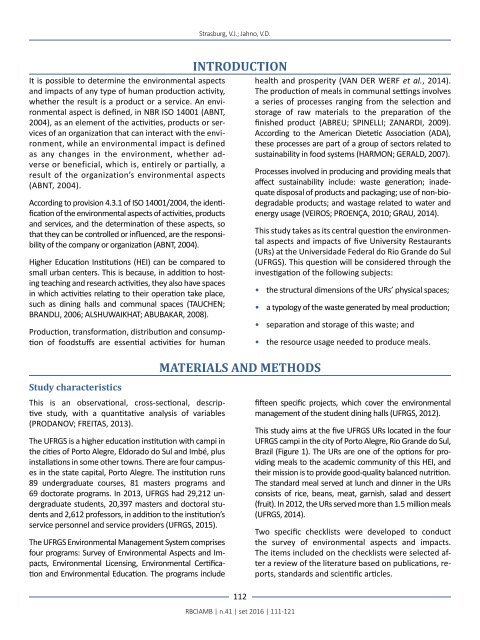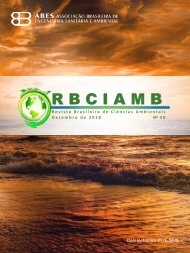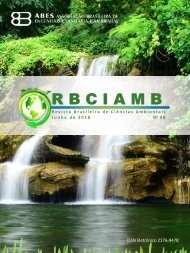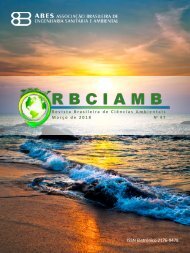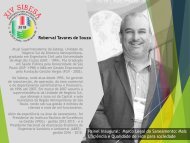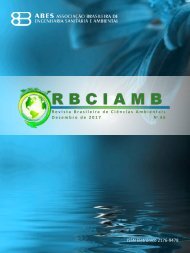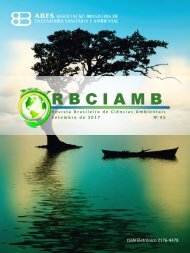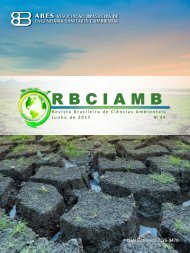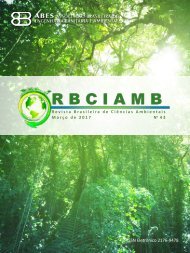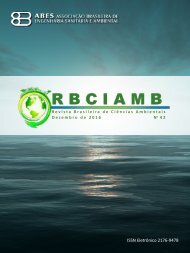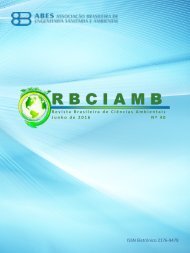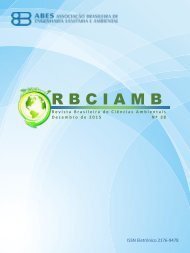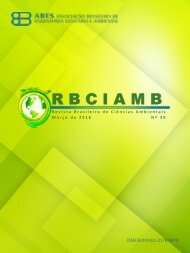EDIÇÃO 41 RBCIAMB
Create successful ePaper yourself
Turn your PDF publications into a flip-book with our unique Google optimized e-Paper software.
Strasburg, V.J.; Jahno, V.D.<br />
It is possible to determine the environmental aspects<br />
and impacts of any type of human production activity,<br />
whether the result is a product or a service. An environmental<br />
aspect is defined, in NBR ISO 14001 (ABNT,<br />
2004), as an element of the activities, products or services<br />
of an organization that can interact with the environment,<br />
while an environmental impact is defined<br />
as any changes in the environment, whether adverse<br />
or beneficial, which is, entirely or partially, a<br />
result of the organization’s environmental aspects<br />
(ABNT, 2004).<br />
According to provision 4.3.1 of ISO 14001/2004, the identification<br />
of the environmental aspects of activities, products<br />
and services, and the determination of these aspects, so<br />
that they can be controlled or influenced, are the responsibility<br />
of the company or organization (ABNT, 2004).<br />
Higher Education Institutions (HEI) can be compared to<br />
small urban centers. This is because, in addition to hosting<br />
teaching and research activities, they also have spaces<br />
in which activities relating to their operation take place,<br />
such as dining halls and communal spaces (TAUCHEN;<br />
BRANDLI, 2006; ALSHUWAIKHAT; ABUBAKAR, 2008).<br />
Production, transformation, distribution and consumption<br />
of foodstuffs are essential activities for human<br />
Study characteristics<br />
This is an observational, cross-sectional, descriptive<br />
study, with a quantitative analysis of variables<br />
(PRODANOV; FREITAS, 2013).<br />
The UFRGS is a higher education institution with campi in<br />
the cities of Porto Alegre, Eldorado do Sul and Imbé, plus<br />
installations in some other towns. There are four campuses<br />
in the state capital, Porto Alegre. The institution runs<br />
89 undergraduate courses, 81 masters programs and<br />
69 doctorate programs. In 2013, UFRGS had 29,212 undergraduate<br />
students, 20,397 masters and doctoral students<br />
and 2,612 professors, in addition to the institution’s<br />
service personnel and service providers (UFRGS, 2015).<br />
The UFRGS Environmental Management System comprises<br />
four programs: Survey of Environmental Aspects and Impacts,<br />
Environmental Licensing, Environmental Certification<br />
and Environmental Education. The programs include<br />
INTRODUCTION<br />
MATERIALS AND METHODS<br />
112<br />
<strong>RBCIAMB</strong> | n.<strong>41</strong> | set 2016 | 111-121<br />
health and prosperity (VAN DER WERF et al., 2014).<br />
The production of meals in communal settings involves<br />
a series of processes ranging from the selection and<br />
storage of raw materials to the preparation of the<br />
finished product (ABREU; SPINELLI; ZANARDI, 2009).<br />
According to the American Dietetic Association (ADA),<br />
these processes are part of a group of sectors related to<br />
sustainability in food systems (HARMON; GERALD, 2007).<br />
Processes involved in producing and providing meals that<br />
affect sustainability include: waste generation; inadequate<br />
disposal of products and packaging; use of non-biodegradable<br />
products; and wastage related to water and<br />
energy usage (VEIROS; PROENÇA, 2010; GRAU, 2014).<br />
This study takes as its central question the environmental<br />
aspects and impacts of five University Restaurants<br />
(URs) at the Universidade Federal do Rio Grande do Sul<br />
(UFRGS). This question will be considered through the<br />
investigation of the following subjects:<br />
• the structural dimensions of the URs’ physical spaces;<br />
• a typology of the waste generated by meal production;<br />
• separation and storage of this waste; and<br />
• the resource usage needed to produce meals.<br />
fifteen specific projects, which cover the environmental<br />
management of the student dining halls (UFRGS, 2012).<br />
This study aims at the five UFRGS URs located in the four<br />
UFRGS campi in the city of Porto Alegre, Rio Grande do Sul,<br />
Brazil (Figure 1). The URs are one of the options for providing<br />
meals to the academic community of this HEI, and<br />
their mission is to provide good-quality balanced nutrition.<br />
The standard meal served at lunch and dinner in the URs<br />
consists of rice, beans, meat, garnish, salad and dessert<br />
(fruit). In 2012, the URs served more than 1.5 million meals<br />
(UFRGS, 2014).<br />
Two specific checklists were developed to conduct<br />
the survey of environmental aspects and impacts.<br />
The items included on the checklists were selected after<br />
a review of the literature based on publications, reports,<br />
standards and scientific articles.


